Thames Water outlines plans to upgrade over 250 sewage treatment and network sites
- matthewgulley6
- Jun 6, 2023
- 3 min read

Thames Water has made a number of significant improvements to its strategy to improve the health of rivers in the Thames catchment, focusing on reducing polluting discharges and working with partners to improve river quality. These efforts are expected to result in phosphorus levels being reduced by 80% by 2025. Additionally, the Thames Tideway Tunnel, which will be completed by 2025, is designed to dramatically improve the water quality of the River Thames.
Thames Water was the first company in the sector to voluntarily provide customers with near-real time information on all untreated sewage discharges across its network with its interactive event duration monitoring (EDM) map. From today, this data will be enhanced with information about the plans for individual sewage works and discharge points.
Customers will now have access to a site-by-site breakdown of where work is or will be taking place and the benefits it will provide. As planned projects are developed, the EDM map will continue to be updated with the latest data to reflect the company’s current plans.
“We are under no illusions of the scale of the challenge ahead of us in improving the health of our rivers and are determined to being transparent about the actions we are taking to significantly reduce discharges,” said Sarah Bentley, Chief Executive of Thames Water.
“Today’s report and upgraded EDM website builds on our decision earlier this year to voluntarily provide near real-time data about all discharges of untreated sewage. We will continue to be open with our customers about how we are investing money to improve performance and reduce discharges.”
In addition to the upgraded EDM map, Thames Water’s updated River Health Action Plan demonstrates the progress the company has made across the three pillars of its strategy to improve the health of rivers in the Thames catchment. The three pillars focus on:
Eliminating polluting discharges to our rivers
Working with partners to improve river quality
Discharging high quality treated effluent that meets all required standards
Eliminating polluting discharges to our rivers
Thames Water continues to deliver targeted pollution reduction activities, such as replacing pumped sewer mains which have failed, reducing blockages by cleaning the sewers, customer education to prevent the incorrect disposal of products into sewers, building up its smart waste programme, and upgrading its sewage treatment works for permit compliance.
Additionally, the Thames Tideway Tunnel, which will be completed by 2025, is designed to dramatically improve the water quality of the River Thames by capturing around 95% of sewage overflows. This investment represents the largest and most significant wastewater project since the creation of the London sewage system in the 1860s.
Working with partners to improve river quality
Thames Water is trialling three Smarter Water Catchments programmes in the Crane, Chess and Evenlode catchments, collaboratively working in partnership with these communities to co-create and co-deliver ten-year improvement plans and investing £9m from 2020 to 2025. For remaining river catchments, Thames Water is spending £5m in a 5-year support fund, focusing on improving the capacity and capability of catchment partnerships.
Discharging high quality treated effluent that meets all required standards
In the Thames catchment, excess phosphorus in the water is a significant problem, and a large proportion of this comes from human wastewater. By 2020, Thames Water had reduced phosphorus levels from historic levels by 74%, and improvements in the company’s current plans, once delivered, will reduce this further to 80% in the first years of its next business plan period beginning in 2025.
.png)


Comments